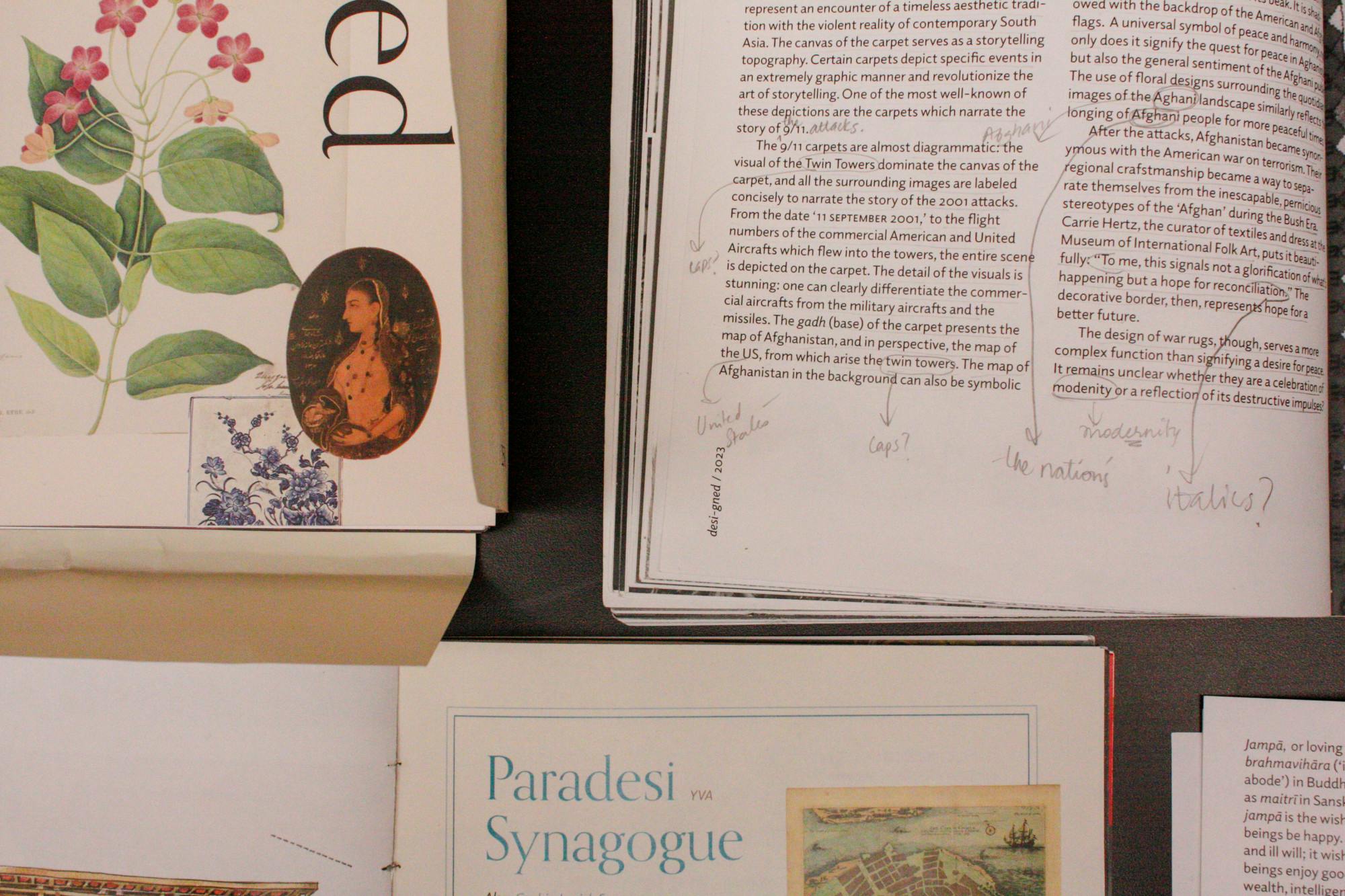When Siddharth Thuppil, a student at the Rhode Island School of Design, introduced Yukti Agarwal ’24.5 to his “birth child,” Agarwal jumped at the opportunity immediately. Together, they created “desi-gned,” New England’s first publication for the South Asian diaspora.
On Thursday, the publication celebrated its inaugural issue at the Rhode Island School of Design Museum’s Grand Gallery.
Agarwal, who currently serves as desi-gned’s editor-in-chief — Thuppil, now graduated, is listed as the founding editor — said the magazine, which combines design, personal reflections and academic research, centers native terminology and seeks to solidify histories created by South Asians.
“There aren’t a lot of knowledge archives of South Asian history,” Agarwal said.
The word “desi,” according to the magazine, is the “ethnonym of the people, cultures and products” of South Asia. The title of the publication, desi-igned, highlights South Asian representation while emphasizing the arts and design aspect of the magazine, according to Agarwal.
Through desi-gned, Agarwal hopes to present South Asian experiences, which are diverse but united by the “relics of human triumph and human suffering,” without “fetishizing our own culture.”
“We were thinking about … what does it mean for us — the South Asians — to live in New England and to study (at) Brown and RISD, which are two (institutions) that were built on colonial exploits and on native lands,” she said. The project explores ways to “contextualize our existence here today in relation with these histories.”
‘Labor of love’: research, writing, funding
desi-gned is divided into four major sections: “material memories,” “spaces and places,” “transcontinental conversations” and “literary musings.”
“Material memories” focuses on the relationships between objects and their histories, according to Agarwal. She cited dowry rugs made in Punjab, which have next to no print or digital documentation of their making, as an example of what the section aims to present.
“Spaces and places” focuses on cross-cultural influences in South Asian architecture, while the “transcontinental conversations” section speaks to South Asia’s own relevance beyond the subcontinent. “literary musings” are “things that inspire us,” Agarwal said.
Agarwal highlighted that one of the main challenges while creating desi-gned with a small group — comprised of Agarwal, Thuppil, a design director and two editors — was capturing the plurality of South Asian culture, especially because the team was made up entirely of Indians. “How do we disassociate ourselves from being Indian and try to be South Asian?” she asked.

While working on the magazine, the team also employed the expertise of Brown and RISD professors.
Kate Irvin ’93, curator and head of the Costume and Textiles department at the RISD Museum, first met Agarwal in 2020 when the pair began to conduct research on Indian textiles. The research led Agarwal to receive a grant that sponsored her investigation of weaving techniques in Kashmir, which ultimately culminated in an article in the magazine.
For Irvin, the magazine expands the concept of scholarship. “It doesn’t always have to be the academic standard of an essay,” she said. “It can be poetry or … beautiful descriptive texts about objects that are personally meaningful.”
Bringing the magazine to life was a “labor of love,” Irvin said — but it also required raising a significant amount of money.
“I sent out close to 250 emails to people to be like, ‘Hey, please, can we have some money for this?’” Agarwal joked. “We’ve gotten close to 70% of our funding from Brown, even though this is a publication that has largely been born at RISD.”
Funding for the magazine came from RISD’s Fleet Library, Brown’s Ruth J. Simmons Center for the Study of Slavery and Justice, the Brown Arts Initiative and Brown’s Saxena Center for Contemporary South Asia, as well as a number of other organizations, according to the publication.
The physical magazine — 150 pages and printed in color — is free for all who wish to read it. A digital version is also available.
“We don’t want to gatekeep information,” Agarwal said. “If someone wants to download it and drag a photograph out … to copy text and use it, that’s something you should be able to do.”
“Beautiful things should not cost money,” she said. “Knowledge should not cost money.”
‘This project has a heritage’: Designing and printing
Mehek Vohra ’24 had never worked on a project of this scale when she was invited to design the magazine. “I had never been educated about my own culture and art from my home,” she said. “This was a really good way not only for me to learn … but also to be more connected with my space.”
For Vohra, one of the biggest challenges was creating a cohesive aesthetic while respecting the visual individuality of each article.
To ensure cohesion, Vohra and Agarwal focused on creating visual motifs scattered throughout the magazine. One such pattern came from “jali,” which refers to “Arabic-inspired stone curtains,” Vohra explained.
It was also important for Agarwal to publish the magazine in print as a way of creating “physical archives of knowledge.”
To print the magazine, the desi-gned team enlisted the help of Doug Scott, a graphic design professor at RISD.
“I am a great believer in printed things because that means this project has a heritage that will last, if not forever, for a long time,” Scott said.
‘Such a beautiful journey’: Celebrating the release
At the launch event in the Grand Gallery at the RISD Museum — a European art gallery — Agarwal said that the team worked to “think about how we can recreate” narratives traditionally centered around European art.
New labels were added to the gallery to “speak about the relationships that these paintings had with South Asia,” Agarwal said. The labels focused on hidden stories of the paintings, like how blue pigment used during the Renaissance came from lapis lazuli stones in Afghanistan.
For Tanvi Anand ’26, desi-gned stands out for its focus on highlighting art and design from South Asia, which is “not really recognized,” she said.
Holding hands, Vohra and Agarwal thanked each other and the people who helped bring the project to life. “I want to thank Yukti,” started Vohra, only to be interrupted by Agarwal. “I want to thank you!”
“It has been such a beautiful journey. I’m really proud of it,” Vohra said to applause.

In the future, Agarwal imagines desi-gned as an annual publication that will accept submissions from all people who “had experiences with South Asia.”
RISD Dean of Libraries Margot McIlwain Nishimura, who has provided support to Agarwal, noted student-led projects often face the challenge of continuing their work and cultivating future leaders.
“I hope that it can be established as an ongoing publication, because … there isn’t any other publication … that really speaks to (the South Asian) community and elevates (its) arts and culture” in this way, Nishimura said.
According to Agarwal, the team has been working to create “a repository” for any student group that would like to share knowledge of “their cultures, their people (and) their perspectives” — with design templates and guides to tackling logistical challenges.
Many people have already expressed interest in joining the publication, Agarwal said. “I'm really excited for someone else to … have experiences like this because it’s made me feel more ready for the world than any internship, any kind of job or class.”

Kathy Wang was the senior editor of community of The Brown Daily Herald's 134th Editorial Board. She previously covered student government and international student life as a University News editor. When she's not at The Herald, you can find her watching cooking videos or writing creative nonfiction.

Julia Vaz was the managing editor of newsroom and vice president on The Herald's 134th Editorial Board. Previously, she covered environment and crime & justice as a Metro editor. A concentrator in political science and modern culture and media, she loves watching Twilight (as a comedy) and casually dropping the fact she is from Brazil.





